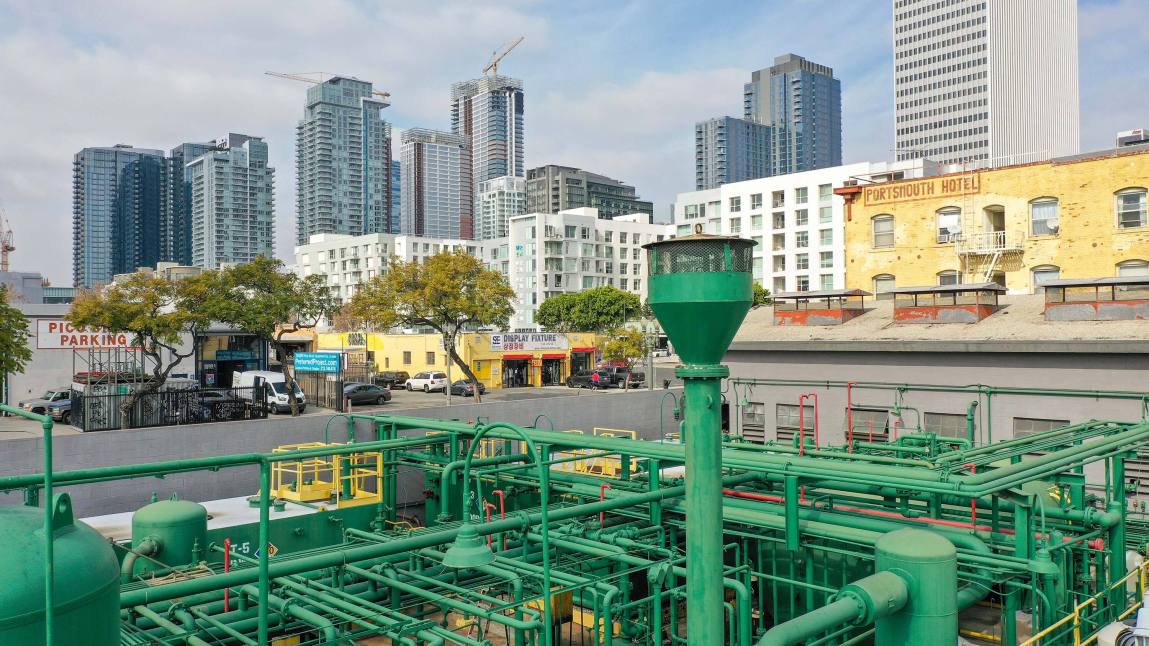On a breezy February afternoon at the ragged edge of rapidly gentrifying downtown Los Angeles, hipsters walk toy dogs along Pico Boulevard. Around the corner on 14th Street, an actor strikes poses for a photo shoot against murals of sunflowers, diamonds and inspirational sayings. The aging, yellow brick residential Portsmouth Hotel sits among knockoff watch dealers here, while a block away, a giant construction crane hoists materials skyward for new luxury apartments.
Below ground is another story. Tucked out of sight, oil wells run thousands of feet deep, tapping thick crude from one of California’s many urban oil fields. And in the fall of 2019, investigators with the state’s oil agency flagged trouble.
Nasco Petroleum was injecting huge amounts of water into well bores above the legal pressure limits, aiming to push more crude out of the aging downtown field. Similarly intense pressure led to a major oil spill in 2006, after a nearby well bore operated by Nasco’s predecessor ruptured. Hot crude and oily waste bubbled up from underground, filled an apartment building basement, oozed out of manhole covers and buckled sidewalks. More than 130 low-income tenants were evacuated.
The pressure wasn’t the investigators’ only concern. They also noted that a number of “bad” wells had been left unfixed for years, with missing cement seals. The wells, investigators wrote in a report to a manager, posed “immediate” risks to drinking water aquifers. They urged supervisors at the California Geologic Energy Management Division, or CalGEM, to take the strongest possible enforcement actions: order Nasco to cease well operations, suspend approvals of the company’s project or both.
No one ever did. While the agency said in a statement that it has taken less stringent measures, like mandating that Nasco lower injection pressure, it declined to provide evidence that the company had complied. Officials acknowledged they remain concerned about potential threats to drinking water, though they said they had no proof of contamination. In January, they said they would address the problems but declined to provide specifics.
“Respectfully, we do not comment on ongoing enforcement actions or investigations in order to preserve their integrity,” spokesman Don Drysdale said in an email.
Today, three of the problematic wells are listed as active on CalGEM’s website. Less than 100 feet from Nasco’s oil operations, low-income residents of the Portsmouth Hotel said they’ve endured decades of problems from the site, including the ground trembling at all hours, fumes that cause headaches and nausea, and equipment catching fire.

“People live in here with fear. … They worry something’s gonna happen, an explosion or something, and we’re not gonna have a chance,” said Gregorio Villegas, the longtime building manager.
A Nasco employee said its wells are operating with no problems. The owner did not respond to requests for comment. Emergency phone numbers on the site’s front entrance are disconnected, and no one responded to knocking on gates.
While California has long sought to maximize oil and gas production, it has recently tried to pair that goal with environmental stewardship. The state’s elected leaders have approved dozens of new staff to better oversee the oil industry and last year changed CalGEM’s mission to prioritize public health and the environment during fossil fuel production. Since 2018, CalGEM officials have pledged to sharply increase the number of enforcement orders they issue — their toughest regulatory hammer. “We’ve been very aggressive in terms of our enforcement,” Gov. Gavin Newsom said last year.
But an investigation by The Desert Sun and ProPublica has found that enforcement is still lax, and in many cases, the state doesn’t know if companies are complying.
Between 2018 and 2020, CalGEM issued 66 enforcement orders. Of those, just 11 have been complied with, while the vast majority remain outstanding, according to agency records and responses. (The news organizations identified an additional 55 orders going back to 2015, but officials said they could not confirm whether companies had complied with orders before 2018, when CalGEM created an enforcement team.)
CalGEM in recent years gained the authority to fine delinquent firms up to $25,000 per day. However, The Desert Sun and ProPublica found that the agency has imposed few fines above $5,000 and has yet to collect one above $35,000. In 2020, CalGEM said it issued $191,669 in civil penalties and collected zero. Many companies continue to violate California’s oil and gas rules with impunity.
According to CalGEM documents the news organizations obtained through public records requests, errant firms have left leaking wells, tanks, sump ponds and other problems across the state, posing threats to public health and wildlife. Photos and inspection reports for several orders show rusted, corroded or oil-coated equipment. Others show holes in netting around sump ponds meant to keep out wildlife and birds attracted by the shiny, sticky pools. At one Central Valley site, inspectors documented unreported “spills of oil” on five separate dates, and they found wastewater being funneled through unlined dirt channels, raising concerns about groundwater contamination. At the edge of the wildfire-prone Los Padres National Forest northwest of Los Angeles, an oil company failed to maintain emergency roads to idle well sites.
In response to questions, CalGEM head Uduak-Joe Ntuk and spokespeople defended the agency’s performance, saying the top priority is protecting the public and the environment. But its own budget requests state that the agency does not have enough employees to “prosecute enforcement actions in a timely manner” or to “adequately protect the health and safety of the citizens of the state.”
“There is currently a substantial backlog” of staff requests, representing a significant “gap between what CalGEM can and should enforce and what it has the staff to enforce,” managers wrote in a January budget request. In fiscal year 2019, for example, the agency issued 35 orders — well short of the 87 it said were requested by staff. In fiscal year 2020, the numbers were even lower, with just 19 orders issued; CalGEM had projected staff would request 138, but the agency declined to provide the final count.
Ntuk, who was appointed by Newsom in November 2019, said cases can take years to develop to guarantee they will withstand legal appeals, and the COVID-19 pandemic had curtailed access to the courts, slowing the process. In the Nasco case, Ntuk said he was not aware that agency inspectors had requested he issue an order.
Still, he said, “We do need to aggressively enforce our statutes and regulations, and I believe we do.”
Some key lawmakers are fed up.
State Sen. Henry Stern, D-Los Angeles, who sits on the Natural Resources and Water Committee, is now calling for an oversight hearing based, in part, on The Desert Sun and ProPublica’s findings. He said they are also weighing potential legislation to tighten CalGEM’s enforcement and to make more oil and gas documents public.
“If the agency is either unable or unwilling to do the job, then the Legislature is going to have to force them to do it,” Stern said. “Oil and gas workers and the communities who live near these sites have the right to know where there are idled or abandoned wells or other equipment that might be leaking or otherwise dangerous. We need to know which sites have not been properly monitored, where faulty records exist and where operators have defied state orders without being fined or shut down.”
A “Useless” Record-keeping System###
The problems are not new. In 2011, a scathing federal audit of CalGEM found shoddy documentation and lax regulation led to failures to protect underground sources of drinking water, like the issues identified in downtown Los Angeles at the Nasco site. In response, in 2015, state officials drew up a “renewal plan,” which they said would prioritize “California’s public safety and environmental health.”
A key piece of the initiative was transitioning from paper files to electronic record-keeping. Officials in 2015 began developing an online system called WellSTAR, or Well Statewide Tracking and Reporting System. The Legislature authorized $52 million for the project. But costs rose year after year, and in one request to lawmakers, CalGEM vowed that if another increase were approved, the agency would guarantee the system contained an enforcement database. By December 2019, the agency had spent $78.8 million, according to a California Department of Technology project review.
Today, CalGEM still has no centralized enforcement database, Ntuk acknowledged. While it has posted some orders on its website, the public has no ready way to know if they’ve been complied with. After additional requests for information from The Desert Sun and ProPublica, the agency said it would begin compiling enforcement efforts in one place.
Texas, another top oil producer, has a public database of all inspections and enforcement actions, which cost about $105,000 to launch, said a spokesman for the state’s Railroad Commission, which oversees oil enforcement. It is updated weekly. Environmentalists and social justice advocates say California should be able to do better.
“You just have to think in the 21st century in the state that has Google, if we can’t figure out a way to do that, something’s wrong,” said Dan Jacobson, state director of Environment California, a group that has monitored the oil industry for years.
Some praise WellSTAR and related mapping systems, saying they allow agency staff and companies to quickly input applications, production numbers and other data. Members of the public can do precise searches of well locations and find out when wells were dug. But enforcement records on WellSTAR are kept private.
“WellSTAR, for all its fancy bells and whistles, is 99% useless,” said Michael Salman, a retired UCLA historian who served as a beta tester of the system for CalGEM. “What if you’re a fire department captain or chief, or zoning official for a city or county tasked with monitoring and regulating oil wells in your jurisdiction, and you need to know what’s going on?”
Ntuk defended the online system. “WellSTAR is not a failure,” he said, noting that in addition to production data, the public and companies now have access to well permits and historical records.

But the lack of enforcement information leaves 2.1 million Californians living within a mile of active oil wells in the dark, with little to no way of knowing if dangers exist from the facilities or if problems are ever rectified. Many oil wells sit in low-income, nonwhite neighborhoods with less political clout, elected officials and experts note.
Compounding the issue, hundreds of pages of documents have vanished from public view on the agency’s website in the past year, such as the Nasco reports. Officials said they had to remove them to comply with a law on making information available to people with disabilities but didn’t explain why the records were not restored.
Stern said he and fellow legislators wanted public access to all agency documents restored.
CalGEM said it has hired a community engagement director and begun a “Transformation Plan” aimed at improving communication and restoring public confidence. Officials there also said the public can file records requests to get answers about enforcement and read the annual reports the agency submits to the Legislature.
It has yet to complete its 2019 annual report. It has also failed to give state legislators and the public legally required updates on programs related to idle wells, underground injection and fracking. CalGEM declined to comment on why the reports had been delayed. “They’re pending,” a senior official said.
A Fight to Collect Fines###
CalGEM has also struggled to impose financial penalties on errant companies.
For years, the agency could only fine a company $25,000 total, no matter how severe a violation. That changed in September 2016, after the huge Aliso Canyon methane gas blowout in Porter Ranch, an upper-middle-class Los Angeles County neighborhood. Lawmakers enabled CalGEM to impose fines of up to $25,000 per day.
CalGEM’s largest penalty ever, a $12.5 million fine against HVI Cat Canyon in 2017, faltered in the courts in part because the agency failed to provide missing paperwork. Negotiations led to a $2 million settlement, but the company is now in bankruptcy, and no payments have been made to date.
Similarly, after news reports about a massive Central California oil spill in 2019, CalGEM again tried to use its new penalty powers. The agency issued an order levying a $2.7 million fine on Chevron, alleging that the firm had failed to prevent or stop numerous spills and moved spilling oil through an unlined dirt channel, creating a significant risk to human health and the environment. While such spills can spontaneously erupt and create deadly sinkholes, the oil company promptly appealed the order. A company official later said Chevron does not believe the spills at issue posed a threat to human health. A year and a half after CalGEM issued the order, the case remains unresolved, in settlement talks. A Chevron spokeswoman said the company had no further comment.
In its own budget requests this year, CalGEM says more staff is needed to get the job done, in part to help enforce a variety of new state laws that expand the agency’s oversight responsibilities. (CalGEM is funded entirely out of per-barrel production fees levied on oil companies.) It says it wants to hire specialists in property records, bonding and other areas to ensure enforcement orders can withstand appeals. Lawmakers are set to evaluate that argument in the coming months as they weigh what to approve in Newsom’s proposed 2021-22 state budget.
State Sen. Monique Limon, D-Santa Barbara, agreed the agency must be fully staffed, but she said it’s currently failing in one of its key duties. “While CalGEM has made strides … they still lack serious enforcement,” she said. She added that the agency must “provide the oversight required to protect the environment and health of Californians.”
But industry officials and even some environmentalists note CalGEM has made nearly identical budget requests for a decade, and it has received funding for more than 120 new staff members since 2010, including six slots to create its first-ever enforcement unit three years ago.
“They have more resources than ever before even as production is falling,” said Rock Zierman, CEO of the California Independent Petroleum Association.
For many environmentalists, whatever CalGEM might do to improve enforcement is too little too late. The state’s oil industry has been drying up for decades, and some companies have been fleeing the state or founding stand-alone units that can declare bankruptcy if necessary. Last year, for the first time in a century, the agency issued more permits to shut down wells than to drill new ones. Officials estimate there are more than 100,000 inactive wells statewide — which a 2020 study predicted could become a $9 billion problem for state taxpayers.
More than half of the orders issued by CalGEM since Newsom took office in 2019 have been for not paying idle well fees. In their current plea to the Legislature for more staff, agency officials say they want to improve compliance with idle well laws. But to do so, they propose decreasing their enforcement actions, to instead “proactively engage with operators at risk of non-compliance.”
“CalGEM is trying, but they’re still far from being a gem of an agency,” said Bill Allayaud, California director of government affairs for the Environmental Working Group, who first sounded alarms about the agency in 2011. “I mean what the heck? It’s been a decade and none of these problems should exist.”


















